The next-gen MacBook Pro with Retina Display Review
by Anand Lal Shimpi on June 23, 2012 4:14 AM EST- Posted in
- Mac
- Apple
- MacBook Pro
- Laptops
- Notebooks
Last year when I wrote about the new MacBook Airs I offered two forward looking paragraphs:
What happens from here on out is what's really interesting. Intel has already committed to moving the TDP of its mainstream parts from 35W - 45W down to 10 - 20W. Since the Air is the new mainstream Mac notebook, Apple has already made that move. The performance in this 10 - 20W segment is going to get much better over the next two years, particularly once Haswell arrives.
The Thunderbolt Display is the first sign of what's to come. Moving IO controllers and expansion into the display, and potentially even moving discrete GPUs out of the notebook are all in store for us. Apple is really ahead of the curve here, but it's easy to imagine a future where laptops become a lot more like the new Air and shift to a couple high bandwidth ports instead of numerous lower bandwidth connections.
Perhaps I was being too aggressive in the prediction of a couple of high bandwidth ports. After all, the next-generation MacBook Pro with Retina Display features four such IO ports (2 x Thunderbolt and 2 x USB 3.0). But you get my point. Gigabit Ethernet and Firewire 800 are both gone. The discrete GPU is still present but I suspect even its days are numbered, at least inside the chassis. The personal computer as we knew it for so long, is changing.
The personal computer is getting thinner, lighter, more integrated and more appliance-like. The movement is no longer confined to just Apple either. The traditional PC OEMs are following suit. Even Microsoft has finally entered the PC hardware business, something it threatened to do for years but hadn't until now. Distribution models will change, the lines between different form factors will continue to blur. What was once a mature industry is going through a significant transformation. It’s exciting but at the same time it makes me uneasy. When I first got into this industry everyone had stories of companies with great ideas that just didn’t make it. As we go through this revolution in computing I’m beginning to see, first hand, the very same.
Apple makes the bulk of its revenue from devices that don’t look like traditional personal computers. For the past couple of years I’ve been worried that it would wake up and decide the traditional Mac is a burden, and it should instead be in the business of strictly selling consumer devices. With its announcements two weeks ago in San Francisco, I can happily say that my fears haven’t come true. At least not yet.
It’s been a while since Apple did a really exciting MacBook Pro launch. Much to my surprise, even the move to Sandy Bridge, the first quad-core in a MacBook Pro, was done without even whispers of a press conference. Apple threw up the new products on its online store, shipped inventory to its retail outlets, updated the website and called it a day. Every iPhone and iPad announcement however was accompanied with much fanfare. The MacBook Pro seemed almost forgotten.
With its WWDC unveil however Apple took something that it had resigned to unexciting, dare I say uncool status, and made a huge deal about it. Two weeks ago Apple did the expected and offered relatively modest upgrades to all of its portable Macs, all while introducing something bold.
Apple calls it the MacBook Pro with Retina Display. You’ll see me refer to it as the next-gen MacBook Pro, Retina MacBook Pro, rMBP or some other permutation of these words.
After using it for the past two weeks I can honestly say it’s the best Mac Apple has ever built. And there’s a lot more to it than hardware.
Portability
If you were hoping for a 15-inch MacBook Air, that’s not what the rMBP is. Instead it is a far more portable 15-inch MacBook Pro. I have to admit I was a bit let down the first time I laid eyes on the next-gen MacBook Pro, it looks good but it doesn’t look all that different. The disappointment quickly faded as I actually picked up the machine and started carrying it around. It’s not ultra light, but man does it make the previous chassis feel dated.
While I never really liked lugging around the old MBP (and it always made me feel like the old fogey at tradeshows where everyone else had something 13-inches or smaller), carrying the rMBP is a pleasure by comparison. Pictures really don’t do it justice. The impressively thin display assembly or overall chassis thickness look neat in a photo but it’s not until you actually live with the rMBP that you can appreciate what Apple has done here. I carry around a 15-inch MacBook Pro because it’s my desktop, and as such it’s incredibly useful to have with me when I travel. For my personal usage model, the Retina MacBook Pro is perfect.
If your workload demands that you need the performance of a MacBook Pro and your lifestyle requires you to carry it around a lot, the reduction in thickness and weight alone will be worth the upgrade to the rMBP. If you spend most of your time stationary however, you’ll have to be sold on the display and internal characteristics alone. The bad news is if the design doesn’t get you, everything else will.

From left to right: 11-inch MacBook Air, 13-inch MacBook Air, 15-inch MacBook Pro, MacBook Pro with Retina Display
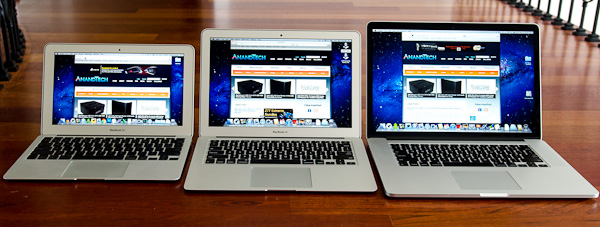
From left to right: 11-inch MacBook Air, 13-inch MacBook Air, MacBook Pro with Retina Display
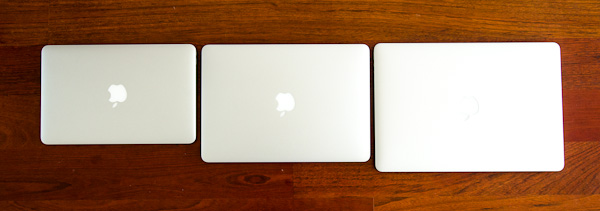
From left to right: 11-inch MacBook Air, 13-inch MacBook Air, MacBook Pro with Retina Display


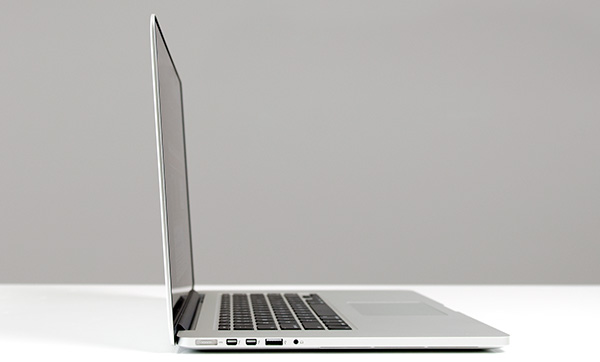
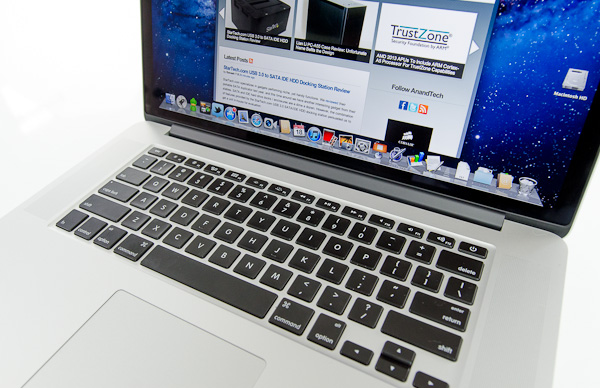
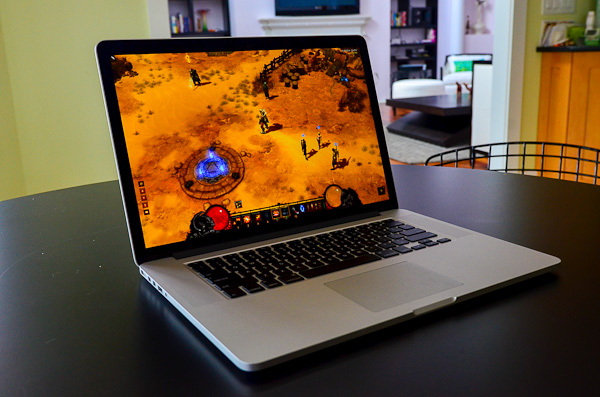
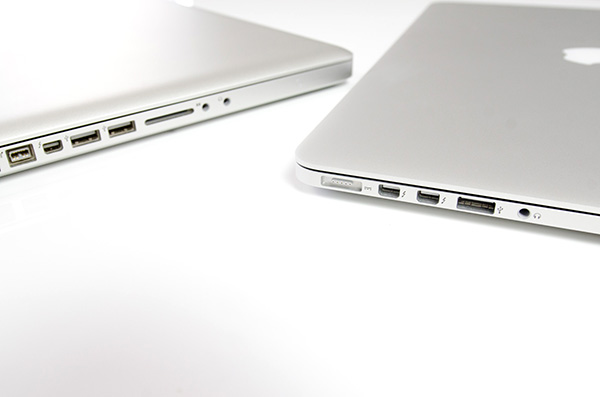
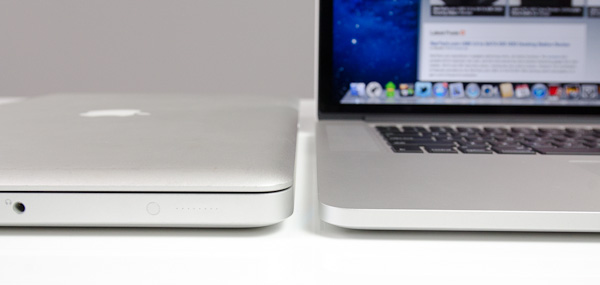








471 Comments
View All Comments
Fx1 - Monday, June 25, 2012 - link
Whine Whine Whine.In the UK we have the best warranty going thanks to UK Regulations and EU protection. Plus 3 year free on education discounts of which i have bought 2 MBP's and never set foot in a university in my life.
Just because in NZ you don't have that protection then blame your gov for not passing legislation.
Also why bitch about Ram? just put the 16GB in and then your good for the next 10 years i expect. £13 a year cost
Spunjji - Tuesday, June 26, 2012 - link
You're so full of shit it's bursting out at the seams. The NZ government have imposed much better consumer warranty protection than we have here in the UK. You might know that if you weren't a fucking cretin who spouts off nonsense before thinking. The fact that you seem to think it's his fault that he lives in NZ where Apple give shitty support just shows what a jingoistic little fanboy you are.That's also an interesting "£13 a year" theory. It'd be neat if it wasn't a complete and utter crock. If more than 10% of these laptops are used regularly for 10 years, Apple pixie magic included, then I will eat my goddamn chair. Maybe you should have gone to university, they could have slammed some sense into your tiny little skull.
Solidstate89 - Sunday, June 24, 2012 - link
"Apple’s impact on the industry has already been felt. The threat of Apple bringing Retina Displays to its entire lineup forced ASUS’ hand and gave us 1080p IPS panels in the new Zenbook Primes."Isn't that a little fucking arrogant to say with absolutely no proof to back that claim up? You know better than anyone how much design work goes into producing these products, and just how LONG the process takes. You really think in just a few months time of rumors, ASUS could have completely revamped their product line-up? Or maybe they were just doing it, because they had already started with the higher resolution displays on their tablet line-up? Or maybe they were even trying to match the absolutely superb and high density display that Sony has been using in their Vaio Z series for all these years.
Claiming just the RUMOR of Apple doing it was UNDOUBTEDLY the influence behind ASUS' IPS, high resolution screens is baseless bullshit. And you know it.
Iketh - Sunday, June 24, 2012 - link
what i don't get is how people could care so much to get pissed off like you... get a hobby!and i agree 100% with Anand's statement... you're blind to not agree, and i'm a PC developer
wfolta - Sunday, June 24, 2012 - link
ASUS may have decided to carry higher resolution displays from their tablets to their laptops, but Apple beat them to the punch with the retina iPad and the rumors of a retina Macbook have been around since at least that far back.Considering most manufacturers have reduced pixel density over time, and considering it was Apple that pushed the retina display first to the iPhone, then the iPad, I think the burden of proof is on you to say that these netbook makers were just itching for higher resolution.
In fact, most of them stopped at the stupid 16:9 1080p (1920x1080) resolution because that's what HD TVs have and they've wanted to tout their ability to play BluRay's at full resolution. There was no concept of making a beautiful display: it was all about a marketing checkbox. And that's what they guy is saying.
kmmatney - Sunday, June 24, 2012 - link
I'm a windows developer - have been for almost 20 years now. I also travel a lot so all my development is done on a laptop, across several virtual machines. I'm currently using a 2007 Dell 17" 1920 x 1200, and have not upgraded yet, waiting for another windows 1920 x 1200 laptop to surface. I've run out of hope now - if Apple comes out with a 17" version of this I'll have to try and convince my company to buy one. I've never used a Mac in my life, but will pay the "Apple tax" to get what I need hardware-wise. I currently have about 20 VMs packed onto a Samsung 256GB 830, so I'm good with storage space.The Windows laptop makers just don't get it - not everyone watch's movies all day - some of us want to use our machines for real work and want to have extra vertical space. Is it that hard to make a 16:10 screen? An ugraded screen is a "3D" screen - really?! The "True-life" screen on my old 2007 Dell is still better than anything you can get nowadays - I've directly compared it with co-corkers brand-new laptops.
KPOM - Sunday, June 24, 2012 - link
Is it possible that Apple's solution for making the rMBP work will scale to the new iPhone? In other words, does it offer Apple a way to increase the screen size without causing a break in compatibility between older and newer apps?gstrickler - Sunday, June 24, 2012 - link
The iPhone and iPad already handle the HiDPI displays, Apple deployed Retina displays there first. The scaling to non integer resolutions is definitely something Apple could do on the iPhone or iPad, but since it takes significantly more CPU/GPU power and affects both performance and battery life, I would not expect it anytime soon. If Apple goes to a larger screen on either device, it's likely that it will support the same total resolution as the current devices and have slightly lower dpi. If we see a 3.7"-4.3" iPhone display, I expect it to be 960x640, just like the current iPhone with Retina display.They already have 4 native resolutions to support on iDevices, 480x320 and 960x640 on iPhone, 1024x768 and 2048x1536 on iPad. I don't believe they'll want to increase that as it has an impact on the hardware, battery life, and every developer, so while it's possible, I think it's unlikely.
raclimja - Sunday, June 24, 2012 - link
Ingadgethrrmph - Sunday, June 24, 2012 - link
This one is *extremely* close to allowing me to replace a full tower workstation and my current laptop. Apple has built a very, very impressive machine that should be a wake-up call to the industry: Move forward, or be left behind.Even so, it falls slightly short of my ideal specs. If Apple would make the next one a 17" or 18" version (please make it Retina, I love the foresight there :), add a 10-Key section to the keyboard, upgrade to Giga-WiFi-ac-1.3Gbs, upgrade the quantity of internal drive ports (yes plural - I can use up to 5 immediately, if they will fit), and pretty please give us a standard drive connector.
While we're at it, can we have all of the drives running at speeds of at least 6.0Gbs? You know, like putting the drives on the current standard mSATA 6.0Gbs connectors, or even hooking them up to a better, newer, smaller, open standard connector at 12.0Gbs.
That's a lot to ask of course, but if they 'just' managed to make it a 17" Retina display, with three drives, with standard connectors, and WiFi-ac-800Mbs, and managed to do it this year, then I would feel they have done as much as anyone could do in in the time available.
If they miss out on delivering a 17" model this year, then it becomes more of a wide open competition where almost anyone could deliver a competitive product in the 17"+ space. After all, the display actually only has to be better than 1920 x 1200 to exceed the specs of my current laptop display.
Right now Apple appears to have the hardware lead and a fairly big one at that. If such a 17"+ machine appears, as described in any of the scenarios above, then it would solidify Apple's hardware lead. With a move like that, Apple would firmly and aggressively cement its position in every laptop screen size category that matters. They could have a compelling position in perhaps 99% of the laptop market.
It would also satisfy my need to have a portable large display machine that can go on infrequent, but very long trips, where I am sometimes remote, and I often need to be fairly self-sufficient and fault tolerant (ie: fix any of the inevitable data glitches myself).
It would improve my situation very significantly if there were sufficient physical drives to have separate system, data, and auto-backup drives internally. Also, having extremely capable external ports is important. So both keeping the existing wired ones just released on the current 15" Retina model, and adding the nascent WiFi-ac wireless internal hardware that is debuting this year in non-Apple equipment, would be super helpful for enhancing my ability for doing redundant off-machine data backups - just in case the internal auto-backup gets thrashed.
In fact if Apple were able to produce such a machine, I would be virtually forced - in a very pragmatic sense - to shell out the cash, move to the dark side, and purchase my first Apple product, ever.
Yes, after 25 years of computing I would lose my patience with the laggards that comprise the rest of the laptop market. With deep, naughty feelings of dark misgiving, I would both splurge and switch allegiance at the same time. I wonder how many others would do the same?
If this should come to pass, then I would inevitably wonder if Apple's real intentions are as wicked as I fear: To eventually try to lock all of us as 'sheeple', into a proprietary hell on Earth. You know... like Sony's thankfully failed attempts to force 'works only here' on us. Umm... let's see... MMC Memory Sticks, anyone?.
Well, back to Apple: Just sayin'... I would do it... even though I know better.
Hey... isn't Microsoft supposed to be getting back into the hardware business in a big way?
What do you think the chances are of a company like Microsoft and a machine like that...
So you're telling me there's a chance... *YEAH!*
-